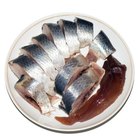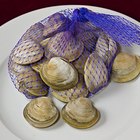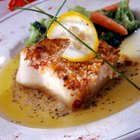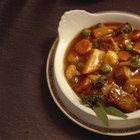
John Foxx/Stockbyte/Getty Images
Bearnaise is a sauce that is a variation on hollandaise -- one of the “mother sauces” in gourmet French cuisine. It is comprised of emulsified egg yolks and butter, and flavored with white wine vinegar, shallots and herbs. It was first created in Paris in the 19th century and was named to honor the province Bearn in southwestern France. Bearnaise is classically served on top of steak. This luscious sauce also works with fish and shellfish.
Origins of a Classic
Chef Jules Colette at the Paris restaurant Le Pavillon Henri IV invented bearnaise sauce in the 1830s. It was named bearnaise in Henry's honor as he was born in Bearn, France and was said to be something of a gourmet when he was alive. Bearnaise translates to meaning "from Bearn." It is a twist on the classic hollandaise sauce and starts as the same base. White wine vinegar, fresh tarragon and peppercorns are then added to the mixture to give it its signature taste and distinctive aroma.
Traditional How-To
To create the sauce, add the vinegar, tarragon, chopped shallots and black peppercorns to a sauce pan. Cook until reduced. Strain the mixture, reserving the liquid. The two main ingredients that give the sauce its body are egg yolks and clarified butter. Clarifying the butter further enhances its taste and is done by slowing melting it and then gradually skimming off the solids. By doing this, the milk solids are removed and all that is left is the flavorful fat. This also makes the butter better able to heat at high temperatures. Egg yolks must be completely separated from the whites and then whisked into the vinegar until fluffy. Add a small amount of the butter a bit at a time and whisk until smooth and thoroughly incorporated.
Deliciously Topped
Bearnaise and steak is a match made in heaven, but this rich, flavorful sauce also works with other red meat. Drizzle it over roast beef to enliven its flavor. Top a plain hamburger with the concoction to elevate an ordinary meal to extraordinary. Bearnaise pairs deliciously with simple roasted fish. It also works well with grilled or sauteed shrimp. Top roasted scallops with bearnaise that has been infused with a bit of lemon to highlight the seafood. Hollandaise has been used to adorn vegetables such as asparagus, and bearnaise can be used in the same way. Pour warm bearnaise over still crisp green beans or over mushrooms served with red meat.
Variations on a Timeless Sauce
Bearnaise sauce classically calls for white wine vinegar while hollandaise calls for white wine. You can however use white wine in bearnaise or, for a slightly different taste profile, swap dry vermouth for the wine or vinegar. Champagne vinegar can also be used. Freshly chopped chervil can also be added along with the tarragon for a richer, earthier taste. Whisk in fresh lemon juice to bearnaise when serving with fish or seafood that has been cooked with citrus. If the sauce is too thick, then water can be slowly added in and whisked until thinned. Bearnaise sauce does not keep long and will usually separate when reheated.
Related Articles
What Can I Make With Cajun Pork Tasso?

How to Make White Sauce for Fish

How to Make Fish Taco Sauce

How to Bake Sicilian Ziti

Types of Pasta Sauces With Tortellini

What Can I Put on Steamed Broccoli ...

How to Cook Shrimp With Butter

How to Cook With Demi-Glace

How to Cook Shrimp for Salad

What Kind of Alcohol Is Good to Cook ...

How to Make Prosecco Sauce

How to Cook a Beef Loin Tri Tip Steak ...

Herring in Wine Sauce

How to Make Fresh Clam Sauce

How to Pan Fry Sea Bass

What If Beef Bourguignon Sauce Does Not ...

How Do You Cook Milanesa Steak?
Lunch Ideas With French Onion Soup

How to Pair Carpaccio With Wine

How to Prepare Teriyaki Tilapia
References
Writer Bio
Candi Canncel is a writer covering food and drinks, travel and lifestyle. Her work has appeared on Food and Wine Travel, Craft Gossip, Belltown Local and other publications. She also teaches cooking classes and hosts food/wine seminars.
Photo Credits
John Foxx/Stockbyte/Getty Images